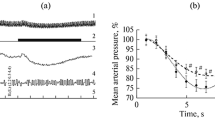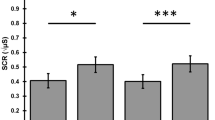Summary
-
1.
Affective behaviour patterns produced by electrical stimulation of the hypothalamus were studied in unanaesthetized, freely-moving cats. Bipolar stimulation with coaxial electrodes and small cathode was used to elicit defence, attack or flight. The development of these responses was studied by varying stimulation strength. In some experiments a stuffed animal was introduced in order to study the reactions of the cat to changes in the environment during stimulation.
-
2.
The following responses were evoked at threshold intensity: (i) growling reaction; (ii) hissing reaction; (iii) two types of flight — type a preceded by hastily looking to and fro as if in search of an exit, type b preceded by inspection of surroundings, in most cases associated with sniffing.
-
3.
Increasing stimulation 1.5 times threshold often yielded combined patterns. At points yielding the growling reaction a defence response in which growls alternated with hisses was obtained. The points yielding flight type a sometimes yielded hissing followed by flight. Increasing stimulation at hissing points yielded either a defence reaction or the combined effect hissing-flight.
-
4.
The growling reactions were obtained from the tuber region. The hissing responses were obtained from points above the tuber. The flight reactions, type a, were produced from the intermediate zone extending from the level of the preoptic area to the mamillary bodies and type b from the caudo-lateral hypothalamus.
-
5.
The reactions of the cats to a dummy during stimulation varied depending on the type of response which had been evoked in the absence of the dummy. The defence reaction was converted into threatening and striking of the dummy, the combined effects into threatening, striking or biting, culminating in sudden flight. The dummy was ignored during stimulation of points yielding flight type a, but examined by sniffing during stimulation of points yielding flight type b.
Similar content being viewed by others
References
Abrahams, V.C., S.M. Hilton and A.W. Zbrozyna: Active muscle vasodilatation produced by stimulatio of the brain stem: Its significance in the defence reaction. J. Physiol. (Lond.) 154, 491–513 (1960).
Brügger, M.: Der Freßtrieb als hypothalamisches Syndrom. Helv. physiol. pharmacol. Acta 1, 183–198 (1943).
Bürgi, S., u. V.M. Bucher: Markhaltige Faserverbindungen im Hirnstamm der Katze. Monographien aus dem Gesamtgebiet der Neurologie und Psychiatrie, fasc. 87. Berlin-Göttingen-Heidelberg: Springer 1960.
Delgado, J.M.R.: Free behavior and brain stimulation. In: International Review of Neurobiology, Vol. 6, pp. 349–449. Ed. by C.C. Pfeiffer and J.R. Smythies. New York and London: Academic Press 1964.
Fernandez de Molina, A., and R.W. Hunsperger: Central representation of affective reactions in forebrain and brainstem: Electrical stimulation of amygdala, stria terminalis, and adjacent structures. J. Physiol. (Lond.) 145, 251–269 (1959).
—: Organization of the subcortical system governing defence and flight reactions in the cat. J. Physiol. (Lond.) 160, 200–213 (1962).
Hediger, H.: Zur Biologie und Psychologie der Flucht bei Tieren. Biol. Zbl. 54, 21–40 (1934).
Hess, W.R.: Beiträge zur Physiologie des Hirnstammes. I. Die Methodik der lokalisierten Reizung und Ausschaltung subkortikaler Hirnabschnitte. Leipzig: Georg Thieme 1932.
—: Das Zwischenhirn. Basel: Benno Schwabe 1949.
—: The functional Organization of the Diencephalon. New York: Grune & Stratton 1957.
—, u. M. Brügger: Das subkortikale Zentrum der affektiven Abwehrreaktion. Helv. physiol. pharmacol. Acta 1, 33–52 (1943).
—, M. Brügger u. V.M. Bucher: Zur Physiologie von Hypothalamus, Area praeoptica und Septum, sowie angrenzender Balken- und Stirnhirnbereiche. Mschr. Psychiat. Neurol. 3, 17–59 (1945/1946).
—, u. H.R. Müller: Schnupperbewegungen als zentrale Reizeffekte. Helv. physiol. pharmacol. Acta 4, 339–345 (1946).
Hilton, S.M., and A.W. Zbrozyna: Amygdaloid region for defence reactions and its efferent pathway to the brainstem. J. Physiol. (Lond.) 165, 160–173 (1963).
Hunsperger, R.W.: Affektreaktionen auf elektrische Reizung im Hirnstamm der Katze. Helv. physiol. pharmacol. Acta 14, 70–92 (1956).
Hutchinson, R.R., and J.W. Renfrew: Stalking attack and eating behaviors elicited from the same sites in the hypothalamus. J. comp. physiol. Psychol. 61, 360–367 (1966).
Levison, P.K., and J.P. Flynn: The objects attacked by cats during stimulation of the hypothalamus. Anim. Behav. 13, 217–220 (1965).
Leyhausen, P.: Verhaltensstudien an Katzen. Z. Tierpsychologie, Beiheft 2 (1956).
Nakao, H.: Emotional behavior produced by hypothalamic stimulation. Amer. J. Physiol. 194, 411–418 (1958).
—: Facilitation and inhibition in centrally induced switch-off behavior in cats. In: Progress in Brain Research, Vol. 27, pp. 128–143. Ed. by W.R. Adey and T. Tokizane. Amsterdam: Elsevier 1967.
—, and M. YOshida: Food intake and other related responses produced by hypothalamic stimulation in cats. Nerv and Brain (Japanese lettering) 16, 657–661 (1964).
Roberts, W.W., and R.J. Carey: Rewarding effect of performance of gnawing aroused by hypothalamic stimulation in the rat. J. comp. physiol. Psychol. 59, 317–324 (1965).
—, and H.O. Kiess: Motivational properties of hypothalamic aggression in cats. J. comp. physiol. Psychol. 58, 187–193 (1964).
Romaniuk, A.: Representation of aggression and flight reaction in the hypothalamus of the cat. Acta Biol. exp. (Warszawa) 25, 177–186 (1965).
Tinbergen, N.: The study of instinct. London: Oxford University Press 1951.
Wasman, M., and J.P. Flynn: Directed attack elicited from hypothalamus. Arch. Neurol. (Chic.) 6, 220–227 (1962).
Wyss, O.A.M.: Nouveaux appareils électrophysiologiques (VIII). Helv. physiol. pharmacol. Acta 17, C7-C9 (1959).
—: Beiträge zur elektrophysiologischen Methodik. V. Ein Reizgerät zur konventionellen Impulsreizung. Helv. physiol. pharmacol. Acta 23, 26–30 (1965).
Yasukochi, G.: Emotional responses elicited by electrical stimulation of the hypothalamus in the cat. Folia psychiat. neurol. jap. 14, 260–267 (1960).
Author information
Authors and Affiliations
Rights and permissions
About this article
Cite this article
Brown, J.L., Hunsperger, R.W. & Rosvold, H.E. Defence, attack, and flight elicited by electrical stimulation of the hypothalamus of the cat. Exp Brain Res 8, 113–129 (1969). https://doi.org/10.1007/BF00234534
Received:
Issue Date:
DOI: https://doi.org/10.1007/BF00234534




